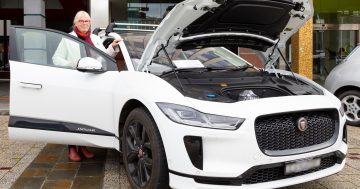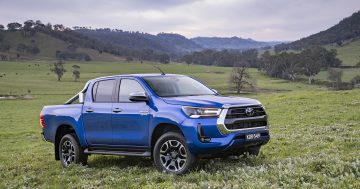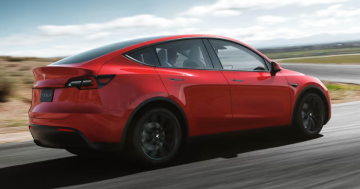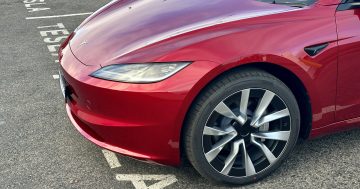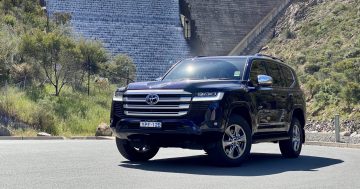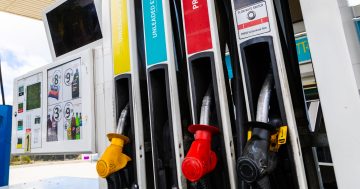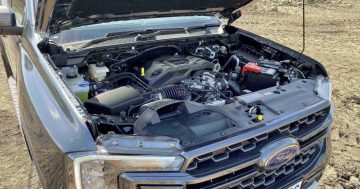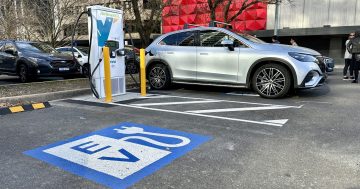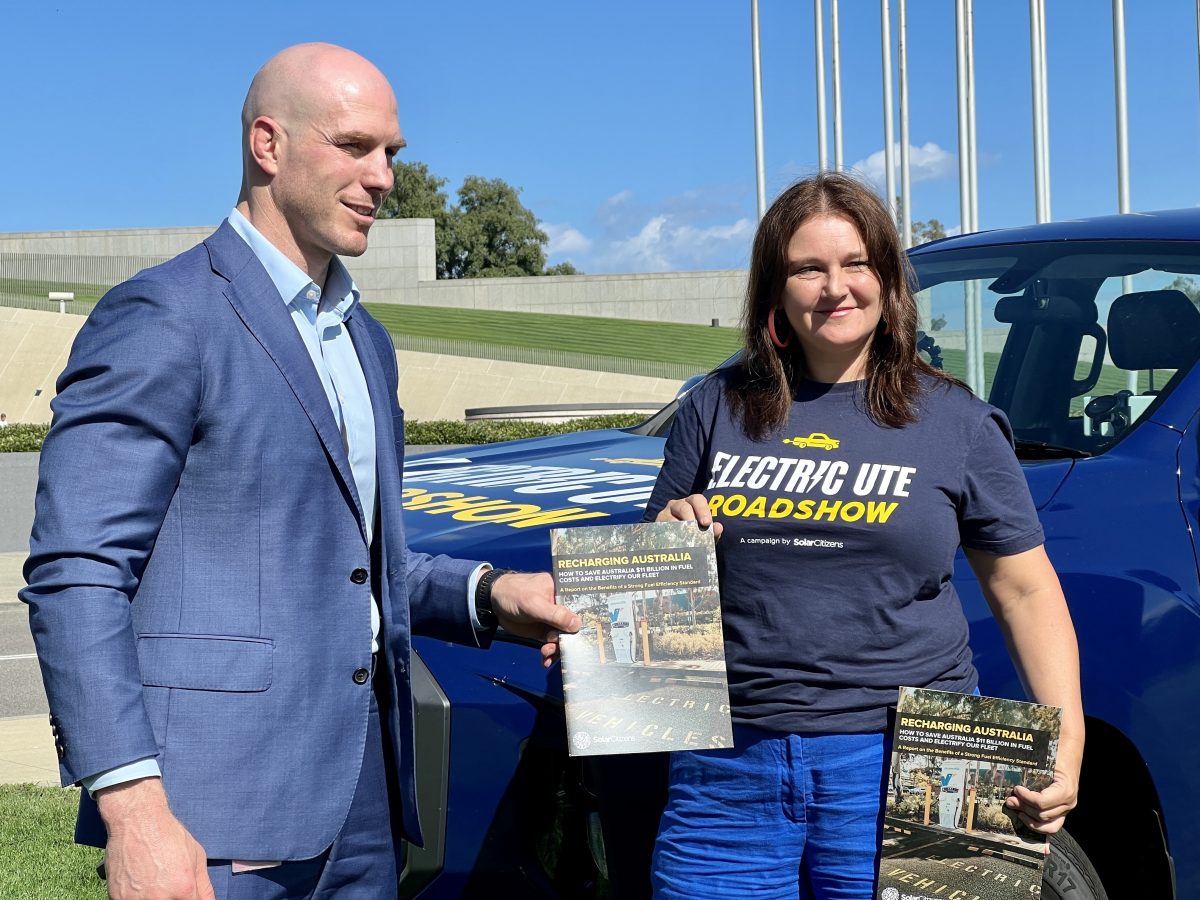
ACT Senator David Pocock and Solar Citizens national director Heidi Douglass at the launch of the Electric Ute Roadshow. Photo: James Coleman.
The ACT’s independent senator has again called for national fuel efficiency standards while sending off Australia’s first pure electric ute on a months-long tour of the country.
Senator David Pocock joined the community-based organisation Solar Citizens and a vinyl-wrapped electric LDV ute on the lawns of Parliament House on Tuesday (28 March) to launch a new campaign on the benefits of ‘Recharging Australia’.
“Australians are currently getting dudded when it comes to the range and price of electric vehicles that are available to us,” he said.
“We are getting sent the world’s clunkers. And in large part, that is because we don’t have fuel-efficiency standards. This is something policymakers need to get on with. The solutions are there.”
It comes as the Australian government works on a National Electric Vehicle Strategy and considers calls to follow the European Union, UK, US, New Zealand and other developed countries in mandating a minimum standard for fuel quality and vehicle emissions.
At the moment, our cars are required to meet the Australian Design Rules, with some additional limits set on harmful emissions such as oxides of sulphur and particulates.
According to data from the Federal Chamber of Automotive Industries (FCAI), new passenger cars and light SUVs sold across Australia in 2021 had average CO2 emissions of 146.5 g per kilometre, while heavy SUVs and light commercial vehicles were up at 212.5 g/km.
Over in Europe, average CO2 emissions need to be below 95 g/km across a car company’s entire range to meet the current Euro 6 standard, with the even stricter rules of Euro 7 on the way. In practice, this means that for every high-emitting model, a car brand also needs an EV.
Senator Pocock said it’s time for Australia to “crack on to world best practice”.
“The EV industry is no longer in its infancy. Starting with fleets, we have to ensure fleets are electrifying now to ensure that in a few years’ time there is a second-hand market that people can afford to buy into. At the same time, we need more models and more competition.”
Solar Citizens is made up of millions of solar energy users from across Australia and describes the Electric Ute Roadshow as “a community campaign to unlock the benefits of affordable electric vehicles for the regions”.
The chariot of choice for the journey is the Chinese-built LDV eT60, the first pure electric dual-cab ute to come to Australia. Prices start at $92,990 and its range is quoted as “up to 330 kilometres”, although that figure is likely to drop by at least half when towing or carrying large loads in the tray.
“It’s got an okay range, but we can get utes that are better than this that are already available overseas if we fix fuel efficiency standards,” Solar Citizens campaigner Ajaya Haikerwal said.
“We’re taking this ute around regional and rural Australia over the next few months, and showing these people they can really save the most, because they pay more for fuel, they drive further, and their cars are older. They have more to gain from this policy.”
The accompanying ‘Recharging Australia’ report analyses data from the Australian Bureau of Statistics (ABS) to reveal what’s likely to happen if Australia adopted the current Euro 6 standard of 95 g/km, gradually dropping the limit to zero grams by 2035.
“Fixing Fuel Efficiency Standards would see car makers send us more efficient petrol, diesel, hybrid and electric vehicles – and Australians could choose vehicles that are cheaper to run and pollute less,” Mr Haikerwal said.



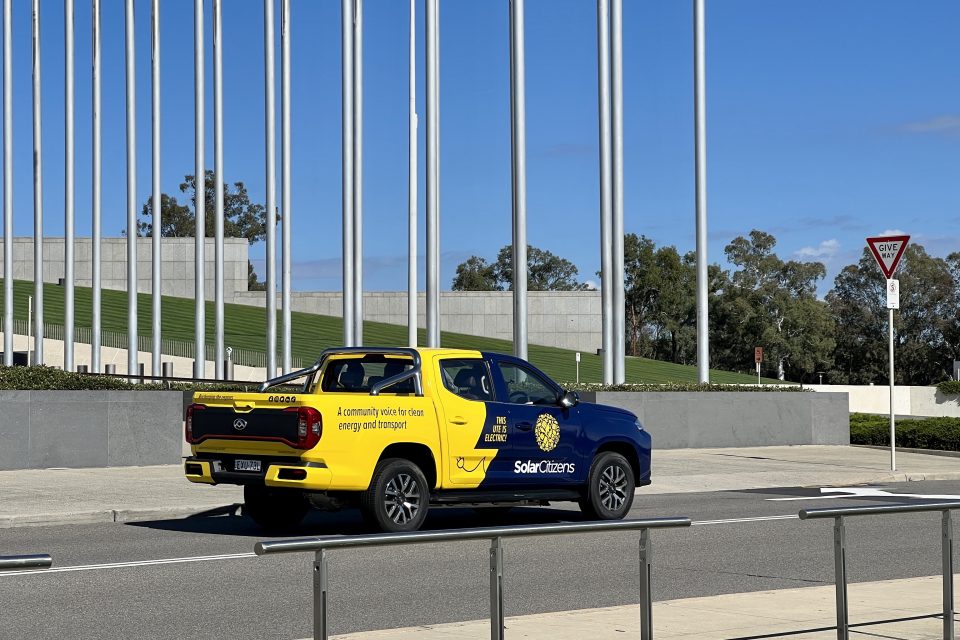


As car makers bring in more EVs to make up for their higher polluting models, Australia would end up with a wider range of EVs – many less than $40,000. This, in turn, means there are more buyers, which the report estimates would cut Australia’s transport emissions by up to 35 per cent each year and save motorists a total of $11.2 billion in fuel costs over five years.
“The cost-saving benefits will be greater for regional drivers, relative to city drivers, because they typically spend a higher per cent of weekly earnings on transport costs,” the report reads.
“When the standard comes into effect, it should send a strong market signal to car makers that they must prioritise a variety of low and zero emission vehicles that suit all Australian motorists – including vehicles suited to regional Australians and for trades, such as utes.”













